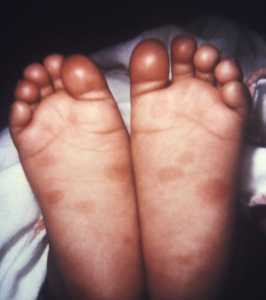Endometriosis: Biomarker May Allow Personalized Approach to Treatment
Maternal Smoking Linked to Early Puberty in Offspring
 Nis Brix M.D., PhD Student
Department of Public Health
Department of Epidemiology
Aarhus University Hospital
MedicalResearch.com: What is the background for this study? What are the main findings?
Response: Several studies have indicated a secular trend towards earlier puberty. This is a potential concern as early puberty has been linked to an increased risk of a number of diseases, such as obesity, diabetes, cardiovascular diseases and certain types of cancer. For this reason, our research team are interested in identifying potential modifiable causes of early puberty.
Smoking during pregnancy may be such a modifiable cause of early puberty in the children. Former studies have already linked smoking during pregnancy to earlier age at the daughters’ first menstrual period, a relatively late marker of pubertal development, but other markers of puberty are less studied, especially in the sons.
We studied 15,819 sons and daughters. The mothers gave detailed information on smoking during their pregnancies, and the children gave information on a number of pubertal milestones half-yearly from the age of 11 years. The milestones for the sons were age at voice break, first ejaculation of semen, pubic hair and testicular growth, armpit hair growth and onset of acne. For the daughters the milestones were age at their first menstrual period, pubic hair growth, breast development, armpit hair growth and onset of acne.
Our results suggested that the more cigarettes the mother smoked during her pregnancy the earlier her children, both sons and daughters, went through puberty. If the mother smoked more than ten cigarettes a day during pregnancy, the children appeared to go through puberty, on average, three to six months earlier than the children of non-smoking mothers. (more…)
Nis Brix M.D., PhD Student
Department of Public Health
Department of Epidemiology
Aarhus University Hospital
MedicalResearch.com: What is the background for this study? What are the main findings?
Response: Several studies have indicated a secular trend towards earlier puberty. This is a potential concern as early puberty has been linked to an increased risk of a number of diseases, such as obesity, diabetes, cardiovascular diseases and certain types of cancer. For this reason, our research team are interested in identifying potential modifiable causes of early puberty.
Smoking during pregnancy may be such a modifiable cause of early puberty in the children. Former studies have already linked smoking during pregnancy to earlier age at the daughters’ first menstrual period, a relatively late marker of pubertal development, but other markers of puberty are less studied, especially in the sons.
We studied 15,819 sons and daughters. The mothers gave detailed information on smoking during their pregnancies, and the children gave information on a number of pubertal milestones half-yearly from the age of 11 years. The milestones for the sons were age at voice break, first ejaculation of semen, pubic hair and testicular growth, armpit hair growth and onset of acne. For the daughters the milestones were age at their first menstrual period, pubic hair growth, breast development, armpit hair growth and onset of acne.
Our results suggested that the more cigarettes the mother smoked during her pregnancy the earlier her children, both sons and daughters, went through puberty. If the mother smoked more than ten cigarettes a day during pregnancy, the children appeared to go through puberty, on average, three to six months earlier than the children of non-smoking mothers. (more…)Neural Tube Defects Are Preventable: Buy Corn Masa Flour and Tortilla Products That Contain Folic Acid
 Vijaya Kancherla, PhD
Research Assistant Professor, Department of Epidemiology
Epidemiologist, Center for Spina Bifida Prevention
Rollins School of Public Health
Emory University
Atlanta GA 30322
MedicalResearch.com: What is the background for this study?
Response: The scientific evidence since 1991 has shown that folic acid prevents from 35%-95% of neural tube birth defects that are caused due to low folic acid (also known as vitamin B9) in the mother’s diet prior to conception and during early pregnancy. Neural tube defects form in the embryo at 4th week of gestation when most women are unaware they are pregnant.
Taking any amount of folic acid after the 4th week of pregnancy will not prevent neural tube defects. There is no cure for these birth defects. So, it matters for women to have enough folic acid prior to conception and in the first four weeks of pregnancy. If a woman is not taking prenatal vitamins that early, folic acid fortified foods come to rescue. Foods fortified with folic acid will prevent folate deficiency for everyone, and offer the benefit to mothers who were not planning their pregnancies or were not taking folic acid pills. If corn masa flour and tortillas were fortified with folic acid, that would help millions of reproductive aged women have healthy stores of folic acid in their bodies, to prepare them for their pregnancy, irrespective of their pregnancy plans.
Prior to April 2016, folic acid (also known as vitamin B9) was not allowed to be added to corn masa flour (or products made from masa such as tortillas and tortilla chips) in the US. So, there was no expectation of having folic acid in these products.
The March of Dimes, Spina Bifida Foundation, the American Academy of Pediatricians, Gruma Corporation and others filed a petition with the US FDA and succeeded in allowing millers to voluntarily add folic acid to corn masa flour and tortillas as a food additive. This regulation was implemented by the US FDA in April 2016. (more…)
Vijaya Kancherla, PhD
Research Assistant Professor, Department of Epidemiology
Epidemiologist, Center for Spina Bifida Prevention
Rollins School of Public Health
Emory University
Atlanta GA 30322
MedicalResearch.com: What is the background for this study?
Response: The scientific evidence since 1991 has shown that folic acid prevents from 35%-95% of neural tube birth defects that are caused due to low folic acid (also known as vitamin B9) in the mother’s diet prior to conception and during early pregnancy. Neural tube defects form in the embryo at 4th week of gestation when most women are unaware they are pregnant.
Taking any amount of folic acid after the 4th week of pregnancy will not prevent neural tube defects. There is no cure for these birth defects. So, it matters for women to have enough folic acid prior to conception and in the first four weeks of pregnancy. If a woman is not taking prenatal vitamins that early, folic acid fortified foods come to rescue. Foods fortified with folic acid will prevent folate deficiency for everyone, and offer the benefit to mothers who were not planning their pregnancies or were not taking folic acid pills. If corn masa flour and tortillas were fortified with folic acid, that would help millions of reproductive aged women have healthy stores of folic acid in their bodies, to prepare them for their pregnancy, irrespective of their pregnancy plans.
Prior to April 2016, folic acid (also known as vitamin B9) was not allowed to be added to corn masa flour (or products made from masa such as tortillas and tortilla chips) in the US. So, there was no expectation of having folic acid in these products.
The March of Dimes, Spina Bifida Foundation, the American Academy of Pediatricians, Gruma Corporation and others filed a petition with the US FDA and succeeded in allowing millers to voluntarily add folic acid to corn masa flour and tortillas as a food additive. This regulation was implemented by the US FDA in April 2016. (more…)Dual Stain More Accurate & Efficient for Detecting Cervical Precancers in HPV-Positive Women
- Infection with high-risk human papillomavirus (hrHPV) is the primary cause of cervical cancer. While hrHPV infection is common, most infections are benign and clear on their own without causing cervical cancer. However, some women develop persistent hrHPV infections and are at risk for cervical cancer and its precursors (i.e., precancer).
- The United States Preventative Services Task Force recommends screening every 3 years with cervical cytology (i.e. Pap) alone, every 5 years with hrHPV testing alone, or with a combination of hrHPV testing and cytology (co-testing) for women aged 30 to 65 years.
- Screening with hrHPV testing is highly sensitive for detecting cervical precancer but requires additional triage tests to identify HPV-positive women at high-risk of developing cancer who should undergo colposcopy (visualization of the cervix) and biopsy from those at low-risk who can be safely monitored.
- Currently, Pap cytology is recommended as a triage test for women testing HPV-positive, but this approach requires frequent re-testing at short intervals because the risk of cervical precancer is not low enough in HPV-positive women who test cytology negative to provide long-term reassurance against future risk. In most settings, women who test HPV-positive, cytology-negative are referred to repeat screening within one year.
- The p16/Ki-67 dual stain assay is a molecular test that measures two specific proteins, p16 that is strongly linked with hrHPV infection, and Ki-67, a marker of cell proliferation that is common in precancers and cancers.
- Studies have shown that the dual stain test has greater accuracy for detecting cervical precancers in HPV-positive women compared with cytology.
- In order to determine the optimal screening intervals for the dual stain test, long-term prospective studies are needed to determine how long HPV-positive women who test dual stain negative can be safely reassured of a low precancer risk.
Nolasiban Phase 3 IMPLANT 2 Trial: IVF Live Birth Rate Increased Up to 35%
 Dr. Ernest Loumaye, MD, PhD
Co-Founder and CEO
ObsEva SA
MedicalResearch.com: What is the background for this announcement? How does Nolasiban work to decrease contractions and improve uterine blood flow?
Response: The WHO has recognized infertility as a global health issue, and many couples undergo IVF treatment: there are more than 700,000 annual IVF treatment cycles in Europe and more than 200,000 in the U.S. However, more than 50% of IVF procedures do not result in pregnancy, and failure has tremendous emotional and financial costs to patients. ObsEva is dedicated to improving fertility outcomes in IVF while also supporting the use of single embryo transfer to minimize multiple births that are associated with significant health risks to mother and baby, as well as significant health costs from premature delivery.
Nolasiban works by blocking the hormone oxytocin, which is known to induce uterine contractions. Nolasiban reduces uterine contractions and could improve uterine blood flow, both effects being favourable for the embryo to properly implant. (more…)
Dr. Ernest Loumaye, MD, PhD
Co-Founder and CEO
ObsEva SA
MedicalResearch.com: What is the background for this announcement? How does Nolasiban work to decrease contractions and improve uterine blood flow?
Response: The WHO has recognized infertility as a global health issue, and many couples undergo IVF treatment: there are more than 700,000 annual IVF treatment cycles in Europe and more than 200,000 in the U.S. However, more than 50% of IVF procedures do not result in pregnancy, and failure has tremendous emotional and financial costs to patients. ObsEva is dedicated to improving fertility outcomes in IVF while also supporting the use of single embryo transfer to minimize multiple births that are associated with significant health risks to mother and baby, as well as significant health costs from premature delivery.
Nolasiban works by blocking the hormone oxytocin, which is known to induce uterine contractions. Nolasiban reduces uterine contractions and could improve uterine blood flow, both effects being favourable for the embryo to properly implant. (more…)Combination Oral Contraceptives Associated With Reduced Ovarian Cancer Risk
Our findings are reassuring to women of reproductive age, contemporary combined oral contraceptives (which generally contain lower doses of oestrogen...
Folate Metabolites Linked To Increased Risk of Autism Spectrum Disorder
MedicalResearch.com Interview with: [caption id="attachment_44726" align="alignleft" width="200"] Prof., Hahn[/caption] Juergen Hahn PhD, Professor and Department Head Department of Biomedical Engineerin Department of Chemical &...
Mothers of Infants Born With Major Birth Defect are at Increased Risk of Cardiovasular Disease
Could a Low-Gluten Diet During Pregnancy Protect Offspring from Diabetes?
 Knud Josefsen, senior researcher
Bartholin Institute, Rigshospitalet,
Copenhagen K, Denmark
MedicalResearch.com: What is the background for this study? What are the main findings?
Response: In a large population of pregnant women, we found that the risk of the offspring being diagnosed with type 1 diabetes before the age of 15.6 years (the follow up period) was doubled in the group of women ingesting the highest amounts of gluten (20-66 g/day) versus the group of women ingesting the lowest amounts of gluten (0-7 g/day). For every additional 10 grams of gluten ingested, the risk for type 1 diabetes in the child increased by a factor of 1.31.
It the sense that it was a hypothesis that we specifically tested, we were not surprised. We had seen in animal experiments that a gluten-free diet during pregnancy protected the offspring from diabetes, and we wanted to see if we could prove the same pattern in humans. There could be many reasons why we would not be able to show the association, even if it was there (sample size, low quality data, covariates we could not correct for and so on), but we were off course pleasantly surprised that we found the association that we were looking for, in particular because it is quite robust (more…)
Knud Josefsen, senior researcher
Bartholin Institute, Rigshospitalet,
Copenhagen K, Denmark
MedicalResearch.com: What is the background for this study? What are the main findings?
Response: In a large population of pregnant women, we found that the risk of the offspring being diagnosed with type 1 diabetes before the age of 15.6 years (the follow up period) was doubled in the group of women ingesting the highest amounts of gluten (20-66 g/day) versus the group of women ingesting the lowest amounts of gluten (0-7 g/day). For every additional 10 grams of gluten ingested, the risk for type 1 diabetes in the child increased by a factor of 1.31.
It the sense that it was a hypothesis that we specifically tested, we were not surprised. We had seen in animal experiments that a gluten-free diet during pregnancy protected the offspring from diabetes, and we wanted to see if we could prove the same pattern in humans. There could be many reasons why we would not be able to show the association, even if it was there (sample size, low quality data, covariates we could not correct for and so on), but we were off course pleasantly surprised that we found the association that we were looking for, in particular because it is quite robust (more…)Women Who Breast Feed Longer Likely to Have More Children
Babies Born During Peak Pollen Season Have IgE in Cord Blood
 Bircan Erbas, Associate Professor
Reader/Associate Professor, Department of Public Health
School of Psychology & Public Health
La Trobe University
MedicalResearch.com: What is the background for this study?
Response: Around the world allergic respiratory diseases especially in children is a major problem. Studies have already shown that cord blood IgE can be used to identify children at risk for allergic diseases. Our previous research showed that exposure to high levels of outdoor pollen, especially grass, in the first couple of months after birth increased risk of allergic respiratory diseases. Based on this, we suspected that exposure to high grass pollen during pregnancy could be also important. (more…)
Bircan Erbas, Associate Professor
Reader/Associate Professor, Department of Public Health
School of Psychology & Public Health
La Trobe University
MedicalResearch.com: What is the background for this study?
Response: Around the world allergic respiratory diseases especially in children is a major problem. Studies have already shown that cord blood IgE can be used to identify children at risk for allergic diseases. Our previous research showed that exposure to high levels of outdoor pollen, especially grass, in the first couple of months after birth increased risk of allergic respiratory diseases. Based on this, we suspected that exposure to high grass pollen during pregnancy could be also important. (more…)How Does Gestational Diabetes Affect Childhood Diabetes?
USPSTF: All Pregnant Women Should Be Screened For Syphilis
Medicaid Expansion May Increase Access to Birth Control and Family Planning Services
No Premature Menopause Found in Adolescents Who Receive HPV Vaccine
Cervical Cancer: Women Should Discuss PAP Smear, HPV Testing or Both With Their Health Care Provider
HPV Testing or PAP Smear To Screen for Cervical Cancer?
MedicalResearch.com Interview with: [caption id="attachment_44050" align="alignleft" width="150"] Dr. Melnikow[/caption] Joy Melnikow, MD, MPH Professor, Department of Family and Community Medicine Director, Center for Healthcare...
Elective Induction at 39 Weeks May Reduce Need for Cesarean Section
Genes From Dad Influence How Mom Cares for Babies
MedicalResearch.com Interview with: Professor Rosalind John Head of Biomedicine Division, Professor School of Biosciences Cardiff University Cardiff UK MedicalResearch.com: What is the background for this study? What...
ORILISSA™ (elagolix) Now Approved for Management of Moderate to Severe Pain Associated with Endometriosis
Girls with PID Underscreened For Syphilis and HIV in ERs
Young Pregnant Women More Likely To Be Depressed Than Their Mothers
Is Water Immersion During Labor Safe?
Perinatal Folic Acid May Protect Against Serious Mental Illness in Young People
HPV Testing Detects Cervical Pre-Cancer Earlier Than PAP Tests
Women With History of Preeclampsia or Gestational Hypertension Have Increased Risk of Cardiovascular Disease
Are Abortions Safer in Ambulatory Surgery Centers Than Medical Offices?
Immaturity Plays Leading Role in Late Preterm Complications
Forceps and Vacuum Delivery to Reduce Cesareans Could Lead To More Birth Trauma
 Giulia Muraca, PhD, MPH
Postdoctoral Fellow
School of Population and Public Health
BC Children’s Hospital Research Institute
Faculty of Medicine
University of British Columbia
MedicalResearch.com: What is the background for this study? What are the main findings?
Response: While cesarean delivery rates have increased in Canada over the last few decades, as in most industrialized settings, the rate of forceps and vacuum deliveries have declined. These opposing trends have led to recommendations to increase forceps and vacuum delivery rates as a strategy to reduce cesarean delivery rates.
We found that the rate of obstetric trauma in Canada increased significantly in recent years, especially among forceps deliveries. In first-time mothers, the rate of obstetric trauma increased by 7% among forceps deliveries (from 19.4% in 2004 to 26.5% in 2014) and in women who had a previous cesarean delivery, the rate of obstetric trauma among forceps deliveries increased by 9% (from 16.6% to 25.6%).
We found that a 1% increase in the forceps and vacuum delivery rate in Canada was associated with approximately 700 additional cases of obstetric trauma and 18 additional cases of severe birth trauma annually among first-time mothers alone. (more…)
Giulia Muraca, PhD, MPH
Postdoctoral Fellow
School of Population and Public Health
BC Children’s Hospital Research Institute
Faculty of Medicine
University of British Columbia
MedicalResearch.com: What is the background for this study? What are the main findings?
Response: While cesarean delivery rates have increased in Canada over the last few decades, as in most industrialized settings, the rate of forceps and vacuum deliveries have declined. These opposing trends have led to recommendations to increase forceps and vacuum delivery rates as a strategy to reduce cesarean delivery rates.
We found that the rate of obstetric trauma in Canada increased significantly in recent years, especially among forceps deliveries. In first-time mothers, the rate of obstetric trauma increased by 7% among forceps deliveries (from 19.4% in 2004 to 26.5% in 2014) and in women who had a previous cesarean delivery, the rate of obstetric trauma among forceps deliveries increased by 9% (from 16.6% to 25.6%).
We found that a 1% increase in the forceps and vacuum delivery rate in Canada was associated with approximately 700 additional cases of obstetric trauma and 18 additional cases of severe birth trauma annually among first-time mothers alone. (more…)


























